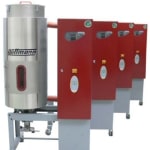 Many resin dryer manufacturers promote their units as being highly efficient and offering energy savings of 50% or more. However, when asked "How much energy does the dryer consume?" or "What is the basis of the energy savings?" there is often little data to support their claims. What the industry really needs is a standard test protocol for measuring dryer energy consumption. In the spring of 2008 Wittmann introduced exactly that.
Many resin dryer manufacturers promote their units as being highly efficient and offering energy savings of 50% or more. However, when asked "How much energy does the dryer consume?" or "What is the basis of the energy savings?" there is often little data to support their claims. What the industry really needs is a standard test protocol for measuring dryer energy consumption. In the spring of 2008 Wittmann introduced exactly that.Wittmann introduced an energy rating standard developed for dry air dryers which clearly defines the ambient conditions and the specific parameters for energy measurement. Basically, the test is performed with the dryer connected to a drying silo filled with resin to provide a true measure of airflow as mass per unit time, in order to determine the standardized energy consumption and arrive at a rating value.
All Wittmann compact dryers are now subject to an energy rating test under controlled conditions and the results displayed on a green energy rating sticker affixed to each dryer. However, only some other manufacturers offer any type of energy rating and test procedures vary, making any valid comparisons difficult at best.
Because of the number of inquiries about resin dryer efficiency, Wittmann has contacted EUROMAP (Europe`s association for plastics and rubber machinery manufactures) to offer their energy rating measurement protocol as the template for establishing a European rating standard.

For example, the difference in dew point behavior can be determined under precisely defined and controlled ambient conditions during testing. Some dryers are unable to perform under typical summer conditions and cannot keep up as shown by the dew point class - a four scale rating of the ability to achieve a specific dew point. Other dryers fail and perform only like hot air dryers.
There was only one type of dryer tested that came close to the low energy consumption offered by Wittmann Drymax dryers but resulted in an insufficient dew point where the resin would absorb moisture. In this case, the dryer achieves low energy consumption but at the expense of dew point performance. The energy rating test was also performed on a honeycomb type dryer from a manufacturer with over 10 years experience in wheel technology. The result was a big surprise in terms of the higher energy consumption as the technology was thought to offer big energy savings.


